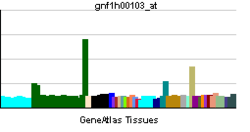ZIC2
| ZIC2 | ||||||
|---|---|---|---|---|---|---|
| Identifiers | ||||||
| Aliases | ZIC2, HPE5, Zic family member 2 | |||||
| External IDs | MGI: 106679 HomoloGene: 5171 GeneCards: ZIC2 | |||||
| RNA expression pattern | ||||||
 | ||||||
| More reference expression data | ||||||
| Orthologs | ||||||
| Species | Human | Mouse | ||||
| Entrez | ||||||
| Ensembl | ||||||
| UniProt | ||||||
| RefSeq (mRNA) | ||||||
| RefSeq (protein) |
| |||||
| Location (UCSC) | Chr 13: 99.98 – 99.99 Mb | Chr 14: 122.48 – 122.48 Mb | ||||
| PubMed search | [1] | [2] | ||||
| Wikidata | ||||||
| View/Edit Human | View/Edit Mouse |
Zinc finger protein ZIC 2 is a protein that in humans is encoded by the ZIC2 gene.[3][4] ZIC2 is a member of the Zinc finger of the cerebellum (ZIC) protein family.[5]
Function
ZIC2 is classified as a ZIC protein due to conservation of the five C2H2 zinc fingers, which enables the protein to interact with DNA and proteins.[4]
Clinical significance
Correct function of these proteins in critical for early development, and as such mutations of the genes encoding these proteins is known to result in various congenital defects. For example, mutation of ZIC2 is known to result in holoprosencephaly due to defect in the function of the organizer region (node), which leads to a defective anterior notochord (ANC). The ANC provides a maintenance signal to the Prechordal plate (PCP), thus a defective ANC results in degradation of the PCP, which is normally responsible for sending a shh signal to the developing forebrain resulting in the formation of the two hemispheres.[6] Holoprosencephaly is the most common structural anomaly of the human forebrain.
Recently ZIC2 has also been shown to be critical for establishment of the left-right axis, thus loss of ZIC2 function can result in defects in heart formation.[7] Another member of the ZIC family, ZIC3, has previously been linked to establishment of the left-right axis.
A polyhistidine tract polymorphism in this gene may be associated with increased risk of neural tube defects (spina bifida). This gene is closely linked to a gene encoding ZIC5, a related family member on chromosome 13.[4]
Interactions
ZIC2 has recently been found to interact with TCF7L2, enabling it to act as a Wnt/β-catenin signalling inhibitor.[8] Such a role is of critical importance, as not only is correct Wnt signalling critical for early development,[9] Wnt signalling has also been found to be upregulated to several cancers. ZIC2 has also been shown to interact with GLI3.[10]
References
- ↑ "Human PubMed Reference:".
- ↑ "Mouse PubMed Reference:".
- ↑ Brown SA, Warburton D, Brown LY, Yu CY, Roeder ER, Stengel-Rutkowski S, Hennekam RC, Muenke M (1998). "Holoprosencephaly due to mutations in ZIC2, a homologue of Drosophila odd-paired". Nat Genet. 20 (2): 180–3. doi:10.1038/2484. PMID 9771712.
- 1 2 3 "Entrez Gene: ZIC2 Zic family member 2 (odd-paired homolog, Drosophila)".
- ↑ Ali RG, Bellchambers HM, Arkell RM (November 2012). "Zinc finger of the cerebellum (Zic): Transcription factors and co-factors". Int J Biochem Cell Bio. 22 (11): 2065–8. doi:10.1016/j.biocel.2012.08.012. PMID 22964024.
- ↑ Warr N, Powles-Glover N, Chappell A, Robson J, Norris D, Arkell RM (October 2008). "Zic2-associated holoprosencephaly is caused by a transient defect in the organizer region during gastrulation". Hum Mol Genet. 17 (19): 2986–96. doi:10.1093/hmg/ddn197. PMID 18617531.
- ↑ Barratt KS, Glanville-Jones HC, Arkell RM (Jun 2013). "The Zic2 gene directs the formation and function of node cilia to control cardiac situs.". Genesis. 52 (6): 626–35. doi:10.1002/dvg.22767. PMID 24585447.
- ↑ Pourebrahim R, Houtmeyers R, Ghogomu S, Janssens S, Thelie A, Tran HT, Langenberg T, Vleminckx K, Bellefroid E, Cassiman JJ, Tejpar S (October 2011). "Transcription factor Zic2 inhibits Wnt/β-catenin protein signaling.". J Biol Chem. 286 (43): 37732–40. doi:10.1074/jbc.M111.242826. PMC 3199516
 . PMID 21908606.
. PMID 21908606. - ↑ Fossat N, Jones V, Khoo PL, Bogani D, Hardy A, Steiner K, Mukhopadhyay M, Westphal H, Nolan PM, Arkell R, Tam PP (February 2011). "Stringent requirement of a proper level of canonical WNT signalling activity for head formation in mouse embryo.". Development. 138 (4): 667–76. doi:10.1242/dev.052803. PMID 21228006.
- ↑ Koyabu Y, Nakata K, Mizugishi K, Aruga J, Mikoshiba K (March 2001). "Physical and functional interactions between Zic and Gli proteins". J. Biol. Chem. 276 (10): 6889–92. doi:10.1074/jbc.C000773200. PMID 11238441.
Further reading
- Houtmeyers R, Souopgui J, Tejpar S, Arkell R (2013). "The ZIC gene family encodes multi-functional proteins essential for patterning and morphogenesis.". Cell Mol Life Sci. 70 (20): 3791–811. doi:10.1007/s00018-013-1285-5. PMID 23443491.
- Brown S, Gersen S, Anyane-Yeboa K, Warburton D (1993). "Preliminary definition of a "critical region" of chromosome 13 in q32: report of 14 cases with 13q deletions and review of the literature.". Am. J. Med. Genet. 45 (1): 52–9. doi:10.1002/ajmg.1320450115. PMID 8418661.
- Brown LY, Odent S, David V, Blayau M, Dubourg C, Apacik C, Delgado MA, Hall BD, Reynolds JF, Sommer A, Wieczorek D, Brown SA, Muenke M (2001). "Holoprosencephaly due to mutations in ZIC2: alanine tract expansion mutations may be caused by parental somatic recombination". Hum. Mol. Genet. 10 (8): 791–6. doi:10.1093/hmg/10.8.791. PMID 11285244.
- Dubourg C, Lazaro L, Pasquier L, Bendavid C, Blayau M, Le Duff F, Durou MR, Odent S, David V (2004). "Molecular screening of SHH, ZIC2, SIX3, and TGIF genes in patients with features of holoprosencephaly spectrum: Mutation review and genotype-phenotype correlations". Hum. Mutat. 24 (1): 43–51. doi:10.1002/humu.20056. PMID 15221788.
- Brown L, Paraso M, Arkell R, Brown S (2005). "In vitro analysis of partial loss-of-function ZIC2 mutations in holoprosencephaly: alanine tract expansion modulates DNA binding and transactivation". Hum. Mol. Genet. 14 (3): 411–20. doi:10.1093/hmg/ddi037. PMID 15590697.
- Ishiguro A, Ideta M, Mikoshiba K, Chen DJ, Aruga J (2007). "ZIC2-dependent transcriptional regulation is mediated by DNA-dependent protein kinase, poly(ADP-ribose) polymerase, and RNA helicase A". J. Biol. Chem. 282 (13): 9983–95. doi:10.1074/jbc.M610821200. PMID 17251188.